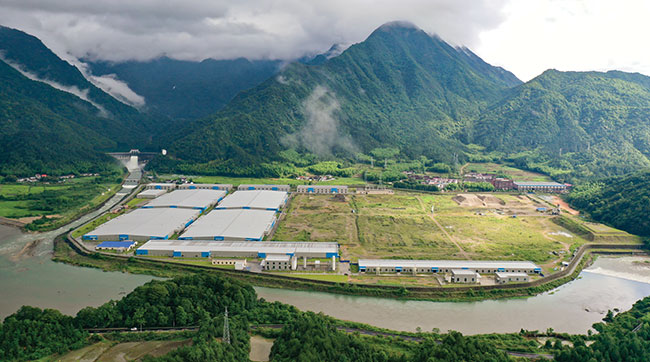
Features
China’s largest eel RAS operation
Ze Hui Aquaculture aims to build sustainable eel RAS industry in China.
September 5, 2024 By Nestor Arellano
 Ze Hui Aquaculture aims to produce about 15,000 tons of eel annually at it’s planned facility in Nanping City. (Photo: Ze Hui aquaculture)
Ze Hui Aquaculture aims to produce about 15,000 tons of eel annually at it’s planned facility in Nanping City. (Photo: Ze Hui aquaculture) In 2012, China exported 71,000 tons of eel valued at US$1.7 billion, according to a country’s General Administration of Customs. With a growth rate of 38.23 per cent year-on-year, China’s eel production industry is seen as one of the largest and fastest growing in the eel production world.
Some reports say that as much as 85 per cent of the world’s eel supply can be traced back to Chinese aquaculture farms. With this growth comes the uncertainty of lack of regulations, traceability and even concerns of around possible glass eel smuggling.
At least one Chinese aquaculture start-up aims to dispel this perception by building what could be the country’s largest recirculating aquaculture system (RAS) facility for raising eel.
Nestled in the foothills of the picturesque old city of Nanping, in the southeastern water-rich Chinese province Fujian if the 520,000 sq. m. facility of Ze Hui Aquaculture. The company aims to produce no less that 15,000 tons of eel annually.
Fujian Province is China’s largest eel producer. In 2021, the province accounted for 43 per cent of the country’s eel production. It was followed closely by Guangdong Province which accounted for 42 per cent.
RAS revamps traditional eel
Ze Hui Aquaculture is among the largest of the handful of eel RAS companies in the country. The rest are small aquaculture operators.
“Currently, eel farming in China is mainly done by small farms, with an annual output of 100-200 tons, and there are more than 1,000 such farms,” according to Changlin Ye, aquaculture operations manager for Ze Hui.
Changlin holds a master’s degree in aquaculture from Nova Scotia’s Dalhousie University. He worked in a tilapia farm in Vancouver from 2014 to 2017. In late of 2017, he decided to go back to China, and join the Ze Hui team.
Many of these smaller “traditional eel farms”, he said, employ flowthrough systems which require large amount of water and endanger the environment. “They discharge a lot of water and produce lots of pollution.”
“The system is affected by external climate, making water quality parameters unstable and prone to disease,” says Changlin. “These are among the pain points that prompted reforms in the eel farming industry.”
The reforms in China’s eel aquaculture space, he says are also geared towards greater sustainability, accountability, product traceability, and improved regulations.
New kid on the block
Ze Hui Aquaculture was founded in 2017 by Naijing Chen, an entrepreneur who was involved in grain trading and real estate development.
Naijing’s hometown had a long history of traditional eel farming. These farms were plagued by drawback such as high-water consumption, uncontrollable farming environment, risks of fish disease, and unstable harvests.
Naijing believed that RAS was the ideal technology for mitigating these risks inherent to the local eel aquaculture.
“Our goal is to become China’s leading eel farming enterprise,” according to Naijing. “We will innovatively develop eel aquaculture and processing business while building a healthy and prosperous eel farming industry.”
Ze Hui contracted Danish RAS technology provider Billund Aquaculture to build the system for the Nanping facility. The US$275 million project included, 560 water tanks, a grow-out building, RAS, eel processing facility, feed production, logistics facility, and a research & development centre.
The ongoing global eel supply challenges resulted in some difficulties for Ze Hui. However, the company sources its glass eel from South America and North America.
The project was divided into two phases. The first phase, which was completed in 2022, reached its targeted annual production of 6,000 tons. The second phase has a target annual production of 10,000 tons.
UltrAqua provided the UV disinfecting systems for the facility and OxyGuard International provided the water monitoring systems.
Protection of the region’s natural ecology and rich water resource was a primary concern for the local government. With Ze Hui’s commitment to sustainability and environmental conservation, the company also received the support of the local government.
Ze Hui also created nearly 200 jobs in the area.
Future of China’s eel industry
Traditional eel farming has been around in China for decades. It was only in the early 1970s that experiments in larger scale eel farming began.
From 2017 to 2021, the country’s production of eel rose from 217, 300 ton to 255, 300 tons.
Today China is one of the largest if not the largest producer of eel in the world.
Chianglin foresee more and more aquaculture operators adopting advance technologies to improve eel production.
“Like the pig and chicken farming industries which have transitioned from small household operations to medium and large enterprises, the eel industry will also undergo integration in the future,” he says. “Most small farms and non-compliant farms will be eliminated.”
“Creating a premium brand is key to winning in the market,” Changlin explains. “On the other hand, continues optimization and improvement in production are needed to increase output and reduce cost.”
Despite its many advantages, the cost of building a RAS eel farm is extremely high compared to that of building a traditional farm.
Part of Ze Hui’s strategy for success is to not limit itself to eel production.
Ze Hui’s facility will also handle eel processing. The facility will have a grilled eel processing factory as well as an eel feed factory with an annual output of 36,000 tons.
Changlin estimates that the company has cornered five per cent of the Chinese eel market. Ze Hui plans to export its products to Japan, United States, Russia, and Southeast Asian nations.
Print this page

